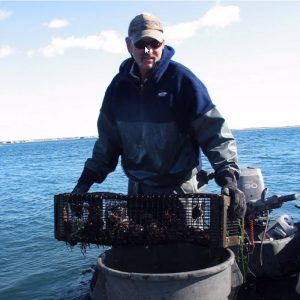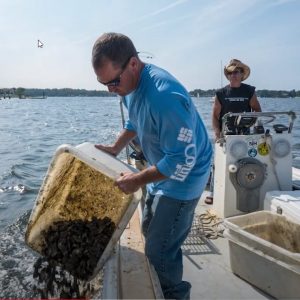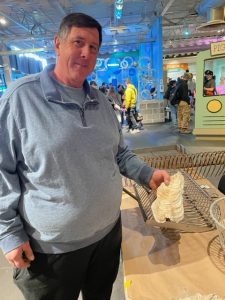Audio & Video Clips
The Fisheries
The south shore is world famous for the many species of fish and shellfish that live year round, spawn or give birth, or rest on their way to warmer or colder habitats. Fluke and flounder, clams and crabs, and bait fish such as killeys, bunker and spearing are just the tip of the ecosystem’s inhabitants. Throughout the history of the south shore, commercial fishermen and baymen have caught these fish in the bay and the ocean in order to sell to the market or for their family meal. Elaborate transportation systems including the Long Island Rail Road provided convenient ways for fishermen to transport their catch, proceeded by ferry boats and followed by roads and highways.
In this section we will explore the traditional commercial fishing activities of area baymen and fishermen. For recent economic and environmental data about commercial fishing, the New York Seafood Council= offers recent studies on sales, seasonal calendars, fish market locations and other helpful information.
Oystering

The oyster houses of Great South Bay employed hundreds of residents during the 19th century. While most of the operations centered on West Sayville, there were other commercial oyster operations throughout the estuary. In 1865 Jacob Ockers was granted an underwater lease from the Town of Brookhaven for 16 acres at a rate of $16 per year for 3 years, to harvest oysters and other shellfish off West Sayville and Oakdale. In 1879 he was granted another lease for $3 per year. Eventually Ockers made enough money to invest in schooners, employing Dutch immigrants to harvest the oysters. The underwater leases would continue until the late 1990s.
Seed oysters were generally harvested in the eastern part of Great South Bay, and then transferred to the western part of the bay where they grew to maturity. Various individuals established operations in West Sayville at the foot of Atlantic Avenue and West Avenue including Jacob Ockers, John Westerbeke, George Vanderborgh, the Kwaak family and Nicholas Griek among others. These settlers established small oyster harvesting operations, borrowing money from more established families like the Greenes and Ockers to build modest houses.
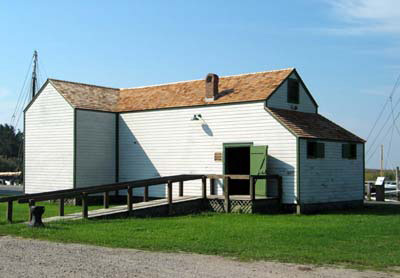
By the 1880s the Great South Bay’s oyster industry was near its peak, producing 70,000 barrels per year. However there was increased pressure in the business climate to consolidate small independently owned oyster companies into larger corporations. Eventually Sealshipt Oyster Company began buying the smaller ones, acquiring the Ockers operations in 1912. As part of the transaction Ockers sold 13,000 acres of bottomlands to Sealshipt, and renaming the company Bluepoints.
The company employed hundreds of Dutch baymen as harvesters who had to sign agreements to work in Bluepoints waters and sell their catch only to the company. According to former baymen Lowell Ockers, the company was stingy in its wages and required baymen to work for them exclusively, rather than work independently. In addition the company required workers to put in 12-hour days without any additional compensation. Workers were paid in cash on Saturday nights by Ockers personally. If an independent baymen needed work in the winter, he was refused employment even temporarily. In 1912 the company had 5 dredge boats: “William McKinley”, “Louisa O.” “Willie K.” “J. Van Wyen” and “Arthur B.” were named after various people including employees in the company. Bluepoints shipped oysters and clams throughout the country and into Europe. In order to harvest the product at the lowest possible cost, Ockers operated approximately 10 schooners in the early 1900s, shipping the shellfish to market by train.
In 1938 a major hurricane struck Long Island, covering the estuary’s valuable oyster beds with sand and mud. Although Bluepoints had begun planting seed oysters grown in Oyster Bay and other communities and the Peconics in the early 1900s, this practice increased after the hurricane to compensate for the lost oyster beds. In addition the company increased its activities in the clam market, using the same equipment and labor force. Oyster and clam hatcheries also grew. These operations continued until 1985, when a mysterious brown tide hit Great South Bay, decimating the bay’s scallop and clam population. The company ceased operations, eventually closing the business in 1999. Today the Nature Conservancy owns the underwater lands, developing small pilot research projects aimed at increasing clam production in the estuary.

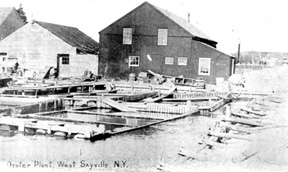
Clamming
For generations baymen have harvested various kinds of clams, which are well known and liked throughout the region. There are several species of clams, including soft shell clams, also called steamers, hard shell clams including cherrystones, chowders, and little necks and top necks. Offshore clam boats harvest ocean skimmer clams. Restaurants often serve skimmer clams in a variety of dishes, ranging from Manhattan and New England clam chowder, white and red clam sauce, fried clams and clam rolls. Many families hosted traditional clambakes on area beaches, a tradition that has less common today.
Early commercial clam operations included the Doxsee Clam Company founded by James H. Doxsee, who was born in Islip in 1825. Doxsee opened the first Long Island clam processing plant in Islip in 1865, which ran until c.1900. The clams were sold to New York City markets as well as local residents. They heavily advertised their products, including the prized clams along with clam juice, which was believed to have medicinal uses, and their world famous clam chowder. In 1900 the company ceased operations due to the depletion of clams throughout Great South Bay. Henry Doxsee moved to Ocracoke, North Carolina where he started a shellfish business. In the same year John Doxsee started setting pound trap nets off Point Lookout.
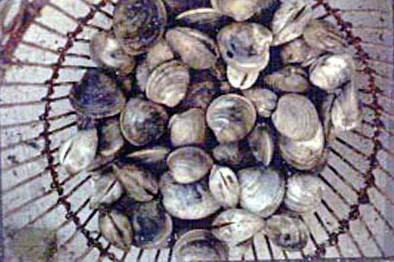
Hard and soft shell clams are found throughout the estuary, including Hempstead Bay and Great South Bay. Clammers use a variety of tools for harvesting including tongs, “bull” rakes, and by treading. Tongs are rarely used today, but are occasionally seen in deeper waters. Bull rakes are so named by baymen because “one has to be as strong as a bull” to pull one. Treading is a traditional practice where one probes the bay bottom with their feet until they feel the clam. Clammers then use their hands to gather the shellfish into a basket. In earlier times boats also “dredged” for clams in the deep waters of Great South Bay, using a conveyor dredge attached to a motor boat to scoop up the clams. This practice was commonly used by the Bluepoints Company, but is no longer used today due to the overall depletion of clams in the bay.
For more information about clams and oysters on Great South Bay click here
Off shore clamming
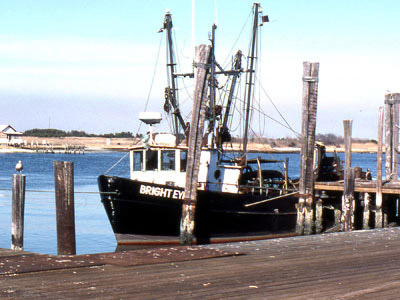
There are several offshore dragger boats who harvest “ocean quahogs” using mechanical dredges. Day boats will sail for approximately 15 hours in nice weather or 10 hours during colder weather. The clams are shucked at dockside and shipped to area fish markets and New York City. The clams are typically found in canned clam chowder, baked and fried clams.
The Doxsee Sea Clam Company in Point Lookout harvested ocean skimmer clams for sale to the general public. Founded in the early 1900s by John Doxsee, the company is run by Bob Doxsee Jr. and his daughter Beth. The company uses two clam dredge boats to harvest the prized shellfish. Other clam boats in the region include the Ashera and the Sturgeon based in Freeport, reminders of the once numerous clam boats that dominated Woodcleft Canal.
Since the 1990s the industry has suffered tremendously due to depleted stocks, restrictions imposed under the Magnuson Act and state regulations, and by competition from out of state boats who fish beyond state jurisdiction. Regulations from the National Marine Fisheries Service are the subject of intense debate, as environmental organizations push for strict conservation measures while commercial and recreational fishermen seek a return to better days. Proposals for offshore windfarms near the fishing and clam beds continue to threaten this traditional industry, a trend that is found throughout the eastern seaboard.
Crabbing
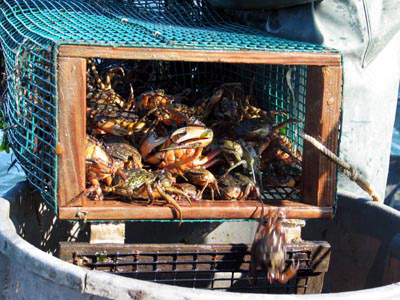
Great South Bay is well known for its blue-claw crabs, a popular delicacy, alongside its crab bait business. Local baymen harvest hard and soft-shell crabs for fish markets and restaurants using crab pots, square wire mesh structures stuffed with menhaden, bunker or other kinds of fish placed in deeper waters. Blue claw crabs are harvested during the molting season for soft-shell crabs or shortly thereafter for hard shell crabs.
In addition baymen harvest brown and green crabs, which are used by sports fishermen to catch fluke, flounder, blue fish and other species. Fishermen typically use horseshoe crabs as bait to catch the green and brown crabs. The traps are rectangular, closely resembling killey traps in design and construction. The crabs are generally found in local bait and tackle shops, and are frequently supplied by charter boat and party boat captains to their customers. Both types of crabs form a significant part of baymen’s livelihoods. Recent regulations of the horseshoe crab by New York and other states have greatly affected the ability of fishermen to work on the bay.
Killey Trapping
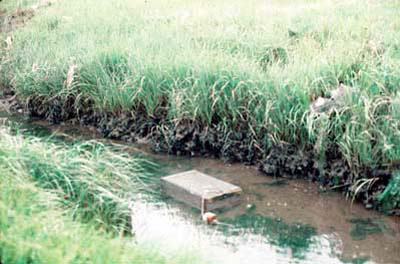
Throughout the estuary baymen trap killies, a small fish that is used for bait by recreational fishermen to catch striped bass, fluke and other types of fish. Killies are small in size, typically 1-1½ inches long, caught in a variety of ways. Commercial fishermen use a rectangular trap with two wooden frames at the end and an interior funnel. Using horseshoe crabs for bait, the killey traps are set in shallow marshlands during low tide and picked up during high tide a few hours later. A typical commercial fisherman will have 50 -100 traps. Since 2001 killies have declined; some fishermen suspect that the spray used to combat West Nile Virus may have damaged the ecosystem upon which killies depend. Most baymen still set their traps, but have sought additional sources of income to combat this recent decline.
Eel Harvesting
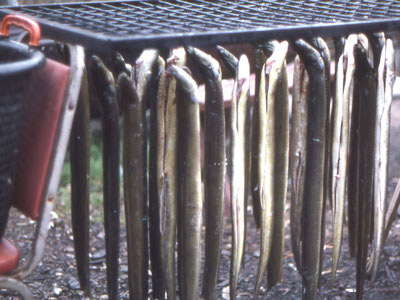
Since the colonial period baymen and fishermen have trapped eels in the south shore estuary during the spring and fall. They are harvested for export to Asian countries, but also for local markets throughout the south shore. Baymen use traps similar in appearance to killey traps, with some important differences. Eel traps have two exterior funnels, and one interior funnel connecting the two chambers in the trap, also called pots. Baymen use horseshoe crabs for bait. The pots are placed in deeper waters than killey traps, for a period of several days. In addition some baymen use eel spears, a practice that was once common in the 1800 and 1900s, made by local blacksmiths for baymen. Other baymen also use combs, so named because they resembled hair combs made of steel.
Some baymen smoke the eels in commercial and homemade smokers. The eels are soaked in brine, a combination of brown sugar, salt and water, for several hours. They are then placed in the smoker where various fruitwoods are used to cook the eels. The eels can take from 6–10 hours to cook. Local baymen such as
In addition to baymen local residents also harvested eels for their family meals and special occasions. Bay house owners are especially known for this.
Fin Fishing
For generations baymen and fishermen have used a variety of techniques and areas to harvest local finfish, including fluke, flounder, black fish, striped bass and other species. In the bay fishermen typically use “pound traps”, a complex series of nets attached to poles staked in the bay and ocean. The Doxsee Sea Clam Company in Point Lookout started using these traps in the early 1930s, a tradition they maintained until the mid 1940s. Other baymen who used pound traps included Lowell Ockers and Tom Duffy, of West Sayville and Patchogue, respectively. This method continues today in various parts of the bay, despite numerous regulations enacted by local municipalities.
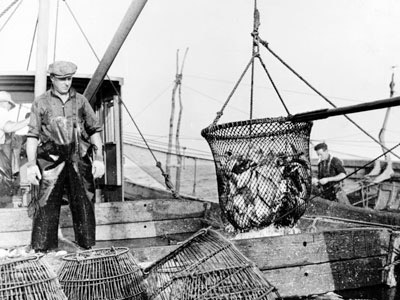
Some baymen like Fred Reimer and John Remsen Jr. use haul seine nets, a traditional method that was once commonly used by area fishermen. Today there are very few baymen who use this method, which was outlawed in many parts of the estuary. The nets are generally 20-feet long, set by boats for a short period of time, perhaps 5 minutes. The fishermen then select the most marketable species, returning the remainder of the catch to the bay.
Gil nets are also used to harvest fin fish. A gill net is typically a net a quarter mile long and of varying depths, depending on the depth of the water it is placed or "set" in. In New York State they must be marked by flags attached to a pole designed to float and affixed to the sea bottom by anchors. Mesh sizes vary depending on the type of fish being caught. For instance a large size mesh will be used to catch big bluefish and striped bass while a smaller size mesh is more appropriate for mackerel. The net is usually set for several hours, often overnight, catching fish that are many times swimming uptide, against the direction of the tidal current. It is called a "gill"-net because the fish are caught head first around the mouth and gills.
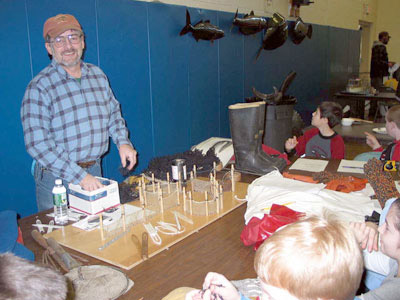
Offshore dragger boats use trawl nets, in order to catch flounder, squid, tuna and other marketable species. These nets range from 50–80 feet long and 40–60 feet high, depending on the targeted species. Like gill nets, trawler nets have different mesh sizes, so that young fish may escape. Many of Long Island’s trawler boats are modest in size, ranging from 40–75 feet long, only going out for day trips. Other larger boats range from 80–200 feet long, sailing for several days at a time to locations several miles offshore. Popular fishing grounds include George’s Banks and the Hudson Canyon. Prior to the early 1980s dragger boats routinely harvested cod, whiting and fluke, also known as summer flounder. Since 1996 government restrictions have severely limited the amount that commercial fishermen may catch, under the Magnuson Act. Other species such as cod have virtually vanished. While there are some offshore lobster boats, they are facing new regulations on what types of pots and trawl lines may be used. As a result many offshore trawl boats no longer operate, due to the high cost of maintaining the boat and their limited ability to harvest fish. In Freeport, for example, there were approximately 12 commercial trawler boats in the 1980s; by 2007 there are only four remaining trawl boats.
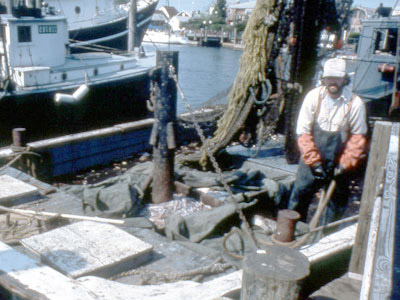
Although trawlers no longer dominate commercial fishing, there are several historic maritime communities that provide dock space to the vessels. They include Point Lookout, Freeport, Bay Shore, Shinnecock Inlet and Montauk. Captains such as Tony Sougstad have spent their entire lives harvesting fish from the ocean. Today he and other fishermen can only fish approximately 60 days each year. As a result there are no apparent successors to this generation of fishermen.
The Future
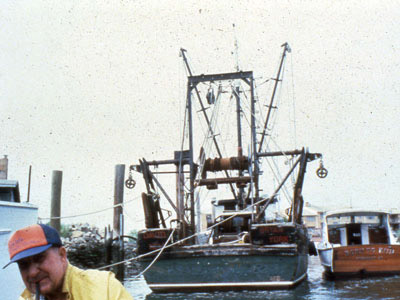
Since the passage of the Magnuson-Stevens Act in 1976, and amended in 1996 and reauthorized in 2006, commercial fishing has severely declined. While there are important benefits to limiting commercial and recreational fish catches, there are also drawbacks, including the demise of traditional fishermen and baymen. Where baymen and fishermen once played an important part in the south shore’s economy, today they are a fraction of a once populous industry. As a result the current generation is actively encouraging their children to pursue alternative occupations, a trend that has been successful. However there are other factors playing a role in this decline. New York State has restrictions on who can hold a fishing license. (see link) In some cases licenses can only be transferred to immediate family members. In other cases no new licenses will be issued. Finally, the flooding of fish markets with imported fish has resulted in a drastic decrease in the amount paid for locally caught fish.


